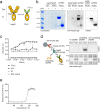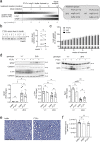Soluble dimeric prion protein ligand activates Adgrg6 receptor but does not rescue early signs of demyelination in PrP-deficient mice
- PMID: 33180885
- PMCID: PMC7660510
- DOI: 10.1371/journal.pone.0242137
Soluble dimeric prion protein ligand activates Adgrg6 receptor but does not rescue early signs of demyelination in PrP-deficient mice
Abstract
The adhesion G-protein coupled receptor Adgrg6 (formerly Gpr126) is instrumental in the development, maintenance and repair of peripheral nervous system myelin. The prion protein (PrP) is a potent activator of Adgrg6 and could be used as a potential therapeutic agent in treating peripheral demyelinating and dysmyelinating diseases. We designed a dimeric Fc-fusion protein comprising the myelinotrophic domain of PrP (FT2Fc), which activated Adgrg6 in vitro and exhibited favorable pharmacokinetic properties for in vivo treatment of peripheral neuropathies. While chronic FT2Fc treatment elicited specific transcriptomic changes in the sciatic nerves of PrP knockout mice, no amelioration of the early molecular signs demyelination was detected. Instead, RNA sequencing of sciatic nerves revealed downregulation of cytoskeletal and sarcomere genes, akin to the gene expression changes seen in myopathic skeletal muscle of PrP overexpressing mice. These results call for caution when devising myelinotrophic therapies based on PrP-derived Adgrg6 ligands. While our treatment approach was not successful, Adgrg6 remains an attractive therapeutic target to be addressed in other disease models or by using different biologically active Adgrg6 ligands.
Conflict of interest statement
The authors have declared that no competing interests exist.
Figures







Similar articles
-
The prion protein is not required for peripheral nerve de- and remyelination after crush injury.PLoS One. 2021 Jan 22;16(1):e0245944. doi: 10.1371/journal.pone.0245944. eCollection 2021. PLoS One. 2021. PMID: 33481951 Free PMC article.
-
The adhesion GPCR Adgrg6 (Gpr126): Insights from the zebrafish model.Genesis. 2021 Apr;59(4):e23417. doi: 10.1002/dvg.23417. Epub 2021 Mar 18. Genesis. 2021. PMID: 33735533 Free PMC article. Review.
-
The prion protein is an agonistic ligand of the G protein-coupled receptor Adgrg6.Nature. 2016 Aug 25;536(7617):464-8. doi: 10.1038/nature19312. Epub 2016 Aug 8. Nature. 2016. PMID: 27501152 Free PMC article.
-
Gpr126 (Adgrg6) is expressed in cell types known to be exposed to mechanical stimuli.Ann N Y Acad Sci. 2019 Nov;1456(1):96-108. doi: 10.1111/nyas.14135. Epub 2019 Jun 19. Ann N Y Acad Sci. 2019. PMID: 31215653
-
Structure, ligands, and roles of GPR126/ADGRG6 in the development and diseases.Genes Dis. 2023 Mar 27;11(1):294-305. doi: 10.1016/j.gendis.2023.02.016. eCollection 2024 Jan. Genes Dis. 2023. PMID: 37588228 Free PMC article. Review.
Cited by
-
The prion protein is not required for peripheral nerve de- and remyelination after crush injury.PLoS One. 2021 Jan 22;16(1):e0245944. doi: 10.1371/journal.pone.0245944. eCollection 2021. PLoS One. 2021. PMID: 33481951 Free PMC article.
-
Glial activation in prion diseases is selectively triggered by neuronal PrPSc.Brain Pathol. 2022 Sep;32(5):e13056. doi: 10.1111/bpa.13056. Epub 2022 Feb 17. Brain Pathol. 2022. PMID: 35178783 Free PMC article.
-
The adhesion GPCR Adgrg6 (Gpr126): Insights from the zebrafish model.Genesis. 2021 Apr;59(4):e23417. doi: 10.1002/dvg.23417. Epub 2021 Mar 18. Genesis. 2021. PMID: 33735533 Free PMC article. Review.
-
Roles of prion proteins in mammalian development.Anim Cells Syst (Seoul). 2024 Dec 10;28(1):551-566. doi: 10.1080/19768354.2024.2436860. eCollection 2024. Anim Cells Syst (Seoul). 2024. PMID: 39664939 Free PMC article. Review.
-
Prion Protein: The Molecule of Many Forms and Faces.Int J Mol Sci. 2022 Jan 22;23(3):1232. doi: 10.3390/ijms23031232. Int J Mol Sci. 2022. PMID: 35163156 Free PMC article. Review.
References
-
- Nishida N, Tremblay P, Sugimoto T, Shigematsu K, Shirabe S, Petromilli C, et al. A mouse prion protein transgene rescues mice deficient for the prion protein gene from purkinje cell degeneration and demyelination. Lab Invest. 1999;79(6):689–97. - PubMed
Publication types
MeSH terms
Substances
LinkOut - more resources
Full Text Sources
Molecular Biology Databases
Research Materials
Miscellaneous

